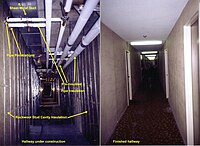
Photo from wikipedia
Abstract Controlling heat transfer and managing heat flows in a building has become very important in recent years and is essential to ensure the thermal comfort of occupants, increase energy… Click to show full abstract
Abstract Controlling heat transfer and managing heat flows in a building has become very important in recent years and is essential to ensure the thermal comfort of occupants, increase energy efficiency, and sustainable development. These measures reduce energy consumption in buildings, save resources and money and at the same time reduce pollution and CO2 emissions into the atmosphere, as the severity of the climate increases. The paper describes the analytical method used to analyse the one-dimensional, steady-state heat transfer through homogeneous walls and composite walls of buildings (wall structure may contain different construction materials, air spaces, insulation, etc.). The web application allows users to analyse one-dimensional and steady-state heat transfer through the building walls and calculate the heat flux density, total heat flux, overall heat transfer coefficient of the building wall, thermal resistance, temperature profile through the wall, the specific thermal resistances and the temperatures at the interface between wall layers. The user can analyse the one-dimensional, steady-state heat transfer through homogeneous and multilayer walls of buildings, being able to analyse a wall composed of a single layer, or one with a maximum of seven layers. The application allows the user, after defining the cross section’s geometry, materials properties, and boundary conditions, to determine the optimal insulation thickness, depending on its placement, on the inner or outer wall surface.
Journal Title: Energy Reports
Year Published: 2020
Link to full text (if available)
Share on Social Media: Sign Up to like & get
recommendations!